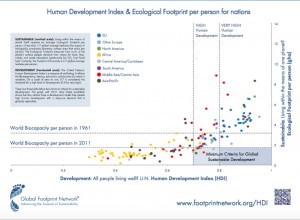Perspective: How Do We Measure SDG Success?
In March 2016, the United Nations will release a set of indicators (up to 100 of them) that countries may use to track their progress on the Sustainable Development Goals. But our friends at the Global Footprint Network have proposed a simpler way to determine whether the actions we take to create sustainable development are working. This article has been adapted and condensed with their permission.
The United Nations has adopted sustainable development as a central agenda. But how do we know whether all the potential activities to achieve the 17 goals (the SDGs) and their 169 targets add up to sustainable development?
“Development” is shorthand for committing to well-being for all. “Sustainable” means that such development must come at no cost to future generations. In other words, development must happen within the boundaries of what the planet’s ecosystems are able to provide, season after season, year after year. Well-being for all needs to be enabled within the means of nature.
This principle was also expressed in possibly the most tangible definition of sustainable development ever formulated, back in 1991: “improving the quality of human life while living within the carrying capacity of supporting eco-systems.” (See “Caring for the Earth”, a report jointly issued by the International Union for the Conservation of Nature – IUCN, the United Nations Development Programme – UNDP, and WWF.)
The goal of “well-being for all” has its own UN-supported metric: the Human Development Index (HDI), which was created by Indian economist Amartya Sen, with his Pakistani colleague Mahbub ul Haq (a former finance minister), to provide an alternative to national income as a standard of development.
HDI is based on the life http://medimagery.com/buyambien/ expectancy, education and income of a nation’s residents. On a scale of zero to one, UNDP defines 0.7 as the threshold for a high level of development (0.8 equates to very high development).
The requirement “within the means of nature” is tracked by the Ecological Footprint. At current population levels, our planet has only 1.7 global hectares (gha) of biologically productive surface area per person. The average Ecological Footprint per person worldwide needs to fall significantly below this threshold if we want to accommodate larger human populations and also provide space for wild species to thrive.
We all want high HDIs for everyone, and we need to make sure to stay within the regenerative capacity of the planet. These two thresholds define two minimum criteria for global sustainable development: an average Footprint that is (significantly) lower than 1.7 gha per person, and an HDI of at least 0.7. (See the graphic to learn how the world’s nations are currently performing on this combination of measurements. Click to enlarge.)
Each nation’s natural endowment and ability to trade vary enormously, of course. But to achieve truly sustainable development, humanity’s demand, at current population levels, has to fall below an average of 1.7 gha per person — a feat which seems daunting but, as the data show, is not impossible.
While we still have far to go, measuring our progress using the basic conditions of sustainable development — well-being and living within nature’s means — can help us navigate the path to success.
— Global Footprint Network. You can view the original article in its entirety here.
Perspective/Tool/Sustainable Development/Goal 3/Goal 12/All Goals


No comments